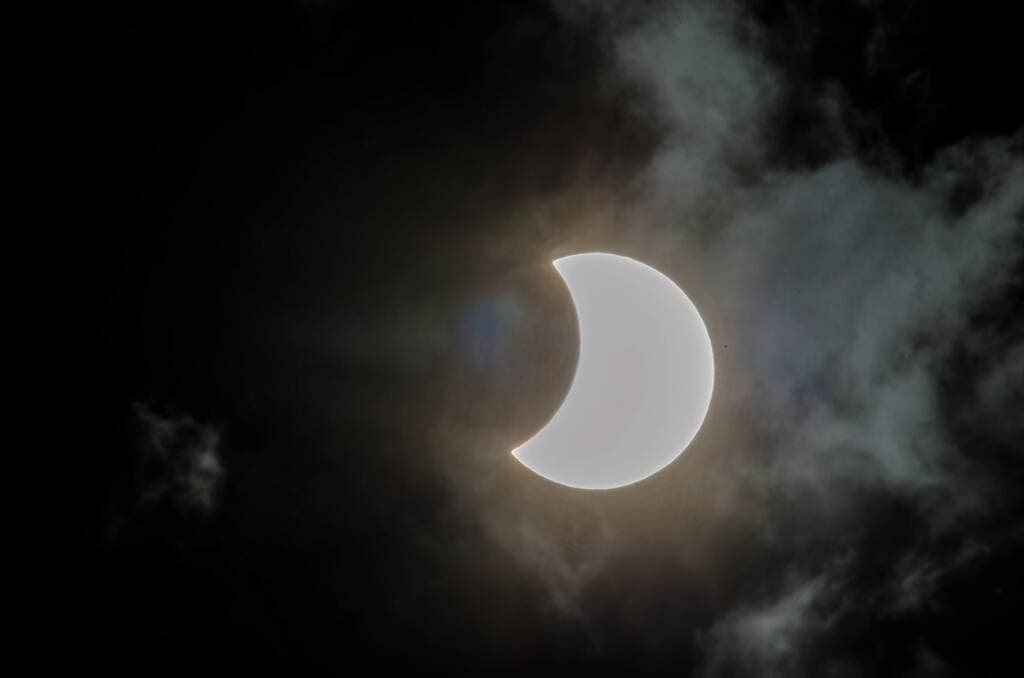Did you know that during a solar eclipse, the gravitational pull of the Moon and Sun aligning can cause a noticeable change in tides?
This fascinating phenomenon is just one of the many ways in which celestial occurrences, such as eclipses, can have far-reaching effects on terrestrial systems.
But it doesn’t stop there. By investigating these celestial events, scientists have also discovered their impact on Earth’s atmospheric dynamics, from changes in weather patterns to the ionization of the upper atmosphere.
We’re going to explore the intriguing relationship between eclipses and tides, as well as delve into the atmospheric dynamics that unfold during these celestial spectacles. Get ready to uncover the mysteries of eclipse phenomena and their profound effects on our planet.
Solar Eclipse Quiz
Test your Solar Eclipse knowledge with these quick 5 fun multiple-choice questions, which offer a fascinating insight into the celestial ballet of the sun, moon, and Earth.

Tidal Effects of Eclipses
Tidal effects of eclipses induce significant changes in atmospheric conditions, including temperature, wind patterns, and ionization.
During an eclipse, the gravitational pull of the Moon and the Sun on the Earth’s atmosphere causes a redistribution of mass.
This leads to a temporary alteration in the atmospheric pressure, resulting in changes in temperature and wind patterns.
The cooling of the atmosphere during a solar eclipse can generate a localized circulation known as the ‘eclipse wind.’
The tidal effects of eclipses impact the ionization in the ionosphere, which can affect radio communications and navigation systems.
Investigating these celestial occurrences and their far-reaching effects on terrestrial systems is crucial for understanding Earth’s atmospheric dynamics.
By studying the tidal effects of eclipses, we can gain insights into the complex interactions between the Earth, Moon, and Sun and enhance our understanding of atmospheric processes.
Atmospheric Dynamics During Eclipses
During eclipses, the interactions between celestial bodies give rise to unique atmospheric dynamics that impact weather conditions and ionization in the upper atmosphere.
These phenomena include drops in temperature and the generation of a local eclipse circulation known as the ‘eclipse wind’.
The cooling effect during eclipses can generate gravity waves, causing fluctuations in atmospheric pressure and affecting ionization in the upper atmosphere.
Solar eclipses can lead to a decrease in ionization due to reduced solar radiation, impacting the density of electrons in the ionosphere and potentially disrupting radio communications and navigation systems.
However, these effects are generally temporary and localized to the region experiencing the eclipse, with disturbances returning to normal after the event.
Researchers take advantage of solar eclipses to study the ionosphere’s response to sudden changes in solar radiation, contributing to improved understanding of ionospheric dynamics.
These investigations play a crucial role in comprehending the far-reaching effects of celestial occurrences on terrestrial systems.
Solar Eclipse and Tropospheric Changes
Solar eclipses have a significant impact on tropospheric changes, influencing weather patterns and atmospheric conditions.
During a solar eclipse, there’s a temporarily reduced input of solar radiation, resulting in a sudden drop in temperature.
This cooling effect affects the troposphere, the lowest layer of Earth’s atmosphere, which is responsible for weather phenomena.
The cooling during an eclipse can generate local circulation patterns known as eclipse wind, which further influence atmospheric dynamics.
Solar eclipses can disrupt radio signals, communication, and navigation systems. This disruption is caused by changes in ionospheric conditions, particularly in the region where the eclipse occurs.
The ionosphere, located in the upper atmosphere, plays a crucial role in reflecting radio waves. Therefore, variations in ionospheric conditions during an eclipse can lead to temporary interruptions in radio communications and navigation.
Stratospheric Impact of Lunar Eclipses
The ‘eclipse wind’ generated during lunar eclipses has a notable impact on the stratosphere, influencing atmospheric circulation patterns and pressure.
Lunar eclipses are part of the celestial occurrences that have far-reaching effects on Earth’s atmospheric dynamics.
During a lunar eclipse, the Earth’s shadow covers the Moon, causing a decrease in solar radiation reaching the upper atmosphere. This reduction in solar heating leads to a cooling effect in the stratosphere.
The resulting temperature gradient creates a localized circulation pattern known as the eclipse wind. This wind can modify the distribution of ozone and other trace gases in the stratosphere, affecting atmospheric pressure and circulation.
Lunar eclipses can also generate gravity waves, which can propagate vertically and horizontally, further influencing atmospheric dynamics.
Understanding the stratospheric impact of lunar eclipses is crucial for investigating the complex interactions between celestial phenomena and Earth’s atmospheric systems.
Eclipse-induced Variations in Upper Atmosphere
The stratospheric impact of lunar eclipses extends beyond atmospheric circulation patterns. During eclipses, the atmospheric cooling can generate gravity waves, leading to fluctuations in atmospheric pressure.
Solar eclipses cause a decrease in ionization and cooling of the upper atmosphere, which affects the ionospheric densities and altitudes.
These changes in the ionosphere can disrupt radio signals, GPS navigation systems, and the propagation of radio waves.
By studying disturbances in Sporadic E during solar eclipses, scientists gain insights into the complex interactions between solar-induced waves and the ionosphere.
Understanding these eclipse-induced variations in the upper atmosphere is crucial for investigating celestial occurrences and their far-reaching effects on terrestrial systems.
For example, these variations play a role in phenomena like tides and Earth’s atmospheric dynamics.
Conclusion
Celestial events like solar and lunar eclipses have a profound impact on Earth’s environment, influencing tides, atmospheric dynamics, and even communication systems.
The intricate interplay between celestial bodies sets off a chain reaction, causing temporary yet significant changes in temperature, wind patterns, ionization, and atmospheric pressure.
This allows Scientists to not only unravel the mysteries of our planet’s atmosphere but also expand our understanding of the complex relationships between celestial bodies and their effects on Earth.
So, the next time you witness an eclipse, take a moment to marvel at the far-reaching consequences of these celestial events and appreciate the critical role they play in shaping our environment.







